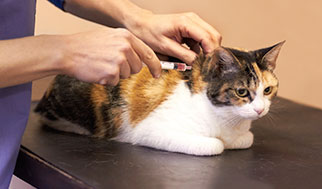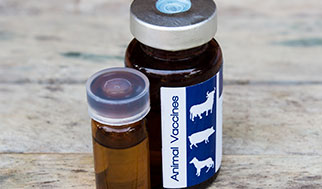Vaccinations
 I prefer to say “So-and-so is in for his Annual”, rather than “So-and-so is in for his shots”.
I prefer to say “So-and-so is in for his Annual”, rather than “So-and-so is in for his shots”.
Why? Because I believe the most important part of the yearly visit is the check-up, and catching problems early.
That is not to undermine the importance of “The Shots”, though – vaccination had reduced many nasty, very serious diseases in dogs to rare occurences.
The most timely of the vaccinations are the puppy/kitten series, and the one-year-later shots.
- Puppy/Kitten Series: The first protection in a puppy or kitten’s life are the antibodies it got from its mother’s first milk (the colostrum). These antibodies are active in its system until anywhere from 8-20 weeks of age. While Mama’s antibodies are still at high levels, they will “mop up” any vaccine antigen we put in, not letting the puppy or kitten’s system get a good look at it. This means that a 6 week, or 8 week, or even later vaccination may not “take”. We repeat vaccination every 3-4 weeks until a last one at 16 to 18 weeks, to make sure we have outlasted Mama’s protection, and the puppy or kitten’s system has had a chance to “learn” the antigen and make their own antibodies to it.
- One-year-later: The young pet’s immune system has had a chance to produce cells to make antibodies; but they don’t keep those cells circulating in the blood stream forever. There comes a time where the immune system decides whether to keep that cell line around or not. When they get a “booster” of the vaccination a year later, it helps the immune system to make a decision about what was important: “Yup, did see that one again – we should turn some of those Antibody-making cells into Memory cells”.
- Adults: once they have had their baby series and the one-year-later shots, there are some vaccinations that can go down to intermittent dosing instead of yearly. Rabies shots (we use a 3-year labeled rabies vaccine) and the Core vaccines (DA2PP for dogs and FRCP for cats) can go down to every 3rd year. We still want them to get their check-up every year; and, some of the other types of vaccinations do need to be yearly to be protective.
- Seniors: As the immune system gets older, it loses efficiency – it may “forget” to keep around some of the cell lines that it should. Also, as pets age, their ability to fight off a disease if they do catch something is lessened. For these reasons, in older pets we may step vaccination back up to yearly.
So what are “The Shots”?
 Core Vaccines – these are the ones we want to give to everybody. Every cat and dog is at risk for these; and keeping the population’s level of immunity high means we are less likely to see outbreaks sweeping through the community.
Core Vaccines – these are the ones we want to give to everybody. Every cat and dog is at risk for these; and keeping the population’s level of immunity high means we are less likely to see outbreaks sweeping through the community.
- Rabies – this is a Public Health issue; it can go to people! It only takes one bite to get it; and it only takes one bite to pass it on. Every pet has the chance of getting a bite at some point in their lifetime. A dog could get out and go adventuring, and find a less-than-friendly raccoon. A strictly indoor cat could find an infected bat in the house: a bat is a mouse with wings… there is no better cat toy, your cat will mess with it.
- FRCP for cats: this prevents 3 different respiratory viruses (Rhinotracheitis, also called Feline Herpes Virus or FHV; Calici virus which causes painful ulcers in the mouth and throat; and Panluekopenia, a virus that starts as respiratory and then goes on to destroy the body’s ability to make white blood cells). The viruses are super tough; they are easy to track home on hands and clothing after you pet that nice cat you met at the Farmer’s Market; and they can aerosolize in through open screen windows if an infected cat is by your house. So even strictly indoor kitties have the potential to be exposed.
- DA2PP for dogs: this one prevents 4 different viruses. Distemper – starts as a respiratory and gastrointestinal illness, and progresses to brain damage; Adenovirus-2 – infects and destroys the liver; Parainfluenza – a respiratory virus that opens the door for other respiratory infections to come in; And Parvo Virus – produces bloody diarrhea, and collapse of the immune system.
“Lifestyle Vaccines” – these are ones we decide whether to give based on your pet’s level of risk.
- FeLV for cats: While Feline Leukemia is a nasty disease, it is a wimpy virus… it does not survive long off the host. This means it can not get tracked home to indoor cats. Cats need to be coming in contact with either infected cats, or very fresh body fluids from infected cats in order to contract the virus. If your cat goes outdoors, or you are bringing foster cats into you home, you should vaccinate for FeLV.
- Leptospirosis for dogs: this disease is caused by a type of bacteria that is secreted into the urine of infected animals. One of the most common carriers is raccoons – they can be infected, and have lots of the bacteria in their kidneys, without getting sick from it. If a dog comes into contact with infected urine, they can contract the disease (and what does a dog do with a pee spot it finds? Snuff-snuff, even lick-lick). This type of bacteria gets into the lining cells of blood vessels, and quickly causes liver and kidney damage. And if your dog gets infected, his urine becomes infectious to you: people can get Lepto too.
- Bordetella (Kennel Cough) for dogs: this one is not as life-threatening as the other diseases; but it is highly contagious and easily spread, and once they contract it it can hang on for months. It is easy for dogs to pick it up anywhere they meet other dogs: the dog park, the groomer’s, doggy daycare, even snuffling noses with a new friend they meet on a walk. No boarding kennel or daycare owner wants to face an epidemic of coughing dogs in their care; this is why many of these facilities require Bordetella vaccination of all the dogs coming in to them.
A regular and well-planned vaccination program gives your pet the tools to protect against serious diseases.

